English translation of the interview between Guido Scanagatta, Director Product Management & Application Automotive at Exide Technologies and Cristina Palumbo for Notiziario Motoristico (Notiziario Motoristico)
Thinking about the electric car, one tends to believe that the only batteries that exist are those that serve to power and move the vehicle, but this is actually not the case at all. On the contrary, as Guido Scanagatta, Director Product Management & Application Engineering Automotive at Exide Technologies, explains, 12-volt batteries are destined to remain a fundamental element, to which the garages and auto repair shops will have to pay more and more attention.
What are the main factors behind the development of batteries in the automotive field and how is this market evolving?
Looking at the evolution of the automotive battery, there was a first significant shift from the traditional battery to the AGM battery. As an original equipment battery manufacturer, Exide has always been at the side of car manufacturers in the research and development of batteries that can meet the changing energy needs of vehicles. This has led us to always actively look for new solutions and in many cases we can state today that Exide is a pioneer in several fields.
We can say that the invention of AGM batteries has been due to the demand of car manufacturers for batteries which are capable of withstanding a lot of cycling. Start&Stop systems required the battery to be able to handle a high number of engine restarts and this required a different solution than traditional lead-calcium technology. Subsequently, other requirements took over, both for vehicles with traditional combustion engines and for hybrid and electric engines.
Locating the battery in other places within the car than the engine compartment and reducing the fuel consumption by disconecting the alternator and thus recover energy from braking have been other requests from the car producing industry, which challenged battery manufacturers to find new solutions.
The drive towards electric power has led to experiments with different technologies, such as the use of lithium. However the need to reduce costs and to have a greater supply chain autonomy in the procurement of materials, as well as the need to comply with regulations concerning their recyclability and reuse, have given a strong impetus for a focus on lead-acid technology.
While the use of lithium technology ensures superior performance in terms of charge acceptance, i.e. the ability to absorb large amounts of energy in a short time, it is also true that it is a much more expensive resource than lead. Not only that - lead is also more easily recyclable and we already have adequate solutions and tools to recover and reuse this material, whereas for lithium batteries in general, the industry is lagging behind.
All these reasons have led Exide Technologies to work on significantly improving the performance of lead-acid batteries, which still have a long life ahead of them, not only for combustion engine applications but also for hybrid and electric vehicles and self-driving cars.
So the push towards electrification will not lead to the disappearance of traditional batteries, as many think and fear?
Absolutely not, on the contrary. Let me explain: This transition towards electrification will continue, even if at the moment, looking at Europe, it is experiencing very differing realities from country to country. Today, we have something like a “two-speed Europe”, where the north is further ahead than the south. In any case, it is clear that the transition has begun and this presents us with new challenges and a new role for the 12-volt battery.
The role of the 12-volt battery in combustion cars is fundamentally linked to starting the engine and maintaining increasingly complex and energy-intensive electronic systems. Its main scope in hybrid and electric cars is related to safety requirements. This is why today, the 12 Volt battery takes on a new role as 'support' for the traction battery. For example, think of a simple rear-end collision with an electric car.
The manufacturers have designed a safety system that isolates the traction battery in the event that it is subjected to acceleration or shocks above a certain threshold, but if it were the only one to manage the vehicle's other electrical systems, such as central locking, it would not be possible to open the doors because the battery is isolated. This is why, depending on the car model, manufacturers have thought about equipping the vehicle with a 'traditional' service battery, the so-called auxiliary battery, so as to ensure that the vehicle's electrical systems are always functioning. We are also thinking of all ADAS devices, which cannot risk to stop functioning in case of need. Precisely for this reason, what we could call a 'redundant approach' is quite widespread, where in electric cars and in general all those with level 2 or 3 autonomous driving, manufacturers require the use of up to two 12-volt auxiliary batteries.
Exide is already supplying such a system to a major manufacturer for an electric SUV. To sum up, not only will lead-acid batteries continue to be used, but we will probably also be faced with new developments in this market, because lead-acid technology makes it possible to have 12-volt batteries that are very cheap, durable, with a life cycle of around six or seven years, and with high recyclability. The difference between the purity of the alloy of a battery made from recycled material or from new raw material is really negligible. Moreover, this technology allows us a European supplier independence that lithium cannot offer.
You talked about collaboration with the OEM. What are the trends and what is Exide working on with car manufacturers?
Basically, the macro-trend concerns the electrification of the car fleet. The numbers may still be low, at least for a part of Europe, but the share of electric vehicles is increasing steadily. We are still talking about 1.4 million registered electric vehicles, a number which will continuously during the coming years. If today in countries like Germany, electric registrations account for about 15 per cent of the total number of cars registered, with the new European regulations it is expected that we will reach a 60 per cent share of registrations by 2035.
Having said that, another very important trend, especially from the point of view of battery production, is the shift towards the use of recycled materials, with important repercussions for the stability of the battery market. At Exide we are working to offer both original equipment and aftermarket products that can meet both performance and recyclability requirements. Today we can say that the largest electric vehicles (the top 20 of the current electric fleet) are equipped with batteries for which Exide offers an aftermarket product.
Regarding the further development in battery technology, the trend points to performance, high cycling resistance and mechanical robustness. The diagnostics will be capable of addressing two needs: communicating with the on-board control unit to indicate whether the 12 V battery is ready to support ADAS, and enabling car repairers to check the status of the battery. Furthermore, as far as OE is concerned, we are already supplying 60-70Ah size AGM auxiliary batteries to manufacturers who will use them on both hybrid and electric vehicles.
Assuming, then, that batteries will continue to be an important component in car maintenance, what do garages need to be prepared for and what kind of service does Exide offer?
The focus is not only on the training needed to work on electric cars, but also on diagnosis and preventive maintenance, something that garages generally pay little attention to. It is difficult for a car repairer to include checking the status of the 12V battery in his car inspection routine, yet this is one of the most effective practices and will become even more vital in future.
Research into the failure rate of a hybrid or electric vehicle shows that the main problem is the 12-volt battery being discharged. The workshop should therefore diagnose during the regular vehicle checks that the 12-volt battery is working properly, not least because this will be subjected to increasingly intensive use and the risk is that they will stop working without warning. Exide offers a tester, the EBT-965P, which makes it possible to quickly and easily check the health of the battery to see if it needs to be replaced before it possibly stops working.
By the way, I would like to emphasise that these new models in particular cannot be replaced by just any old product. Today more than ever it is necessary to replace a battery with a battery that it is equivalent to the original. This is why Exide has also developed an online tool accessible to everyone for identifying the correct replacement battery: our Exide Battery Finder. A simple search with the registration or chassis number is enough to find out not only which model of battery should be used, but also where it is located (information that is by no means trivial or obvious) and whether it is necessary to proceed with battery registration after replacement (an operation for which a diagnostic tool is required).
Again, we provide full information on the procedures to be followed (which, by the way, are different for each vehicle model), because sometimes there are details and sequences to be observed that can be overlooked and that do not allow the battery to be registered correctly and the error to be cleared.
In general, on new cars, it is becoming more and more necessary to use diagnostic tools, as in the case of having to register the battery in the BMS within the vehicle. Specialised personnel; is thus required and the era of do-it-yourself battery changing is coming to an end. Battery management is now the exclusive prerogative of professionals who must adequately prepare themselves for this 'new' task.
In Italy we are trying to make car repairers aware of all these aspects by organising in-depth meetings with our customers regarding the development of the market and of new technologies as well as the service opportunities we offer at both commercial and technical level.









